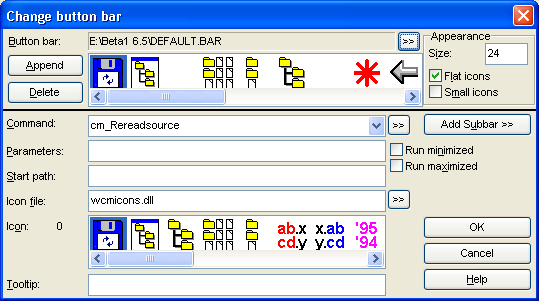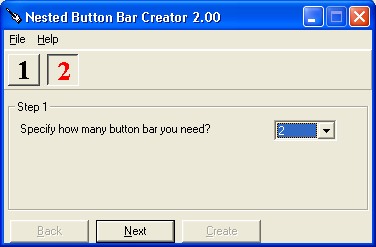Button bar
The button bar in Total Commander is a row of buttons in Total Commander's interface to launch internal commands, external programs or other button bars. The default configuration includes a horizontal button bar at the top and a vertical button bar in the middle. If you leave the mouse cursor over a button for a moment, a tooltip will appear (this can be disabled, see Quickinfo).
You can easily add buttons to the button bar using Drag&Drop (with pressed SHIFT key). By pressing the right mouse button, you can open a local menu, which allows to change or delete buttons. For further changes in the button bar you should use the Dialog box to change the whole button bar.
Dialogbox: Configuration - Change button bar
Hint: By dragging a file on the button bar with pressed SHIFT key you can easily add buttons to the button bar. By pressing the right mouse button on the button bar, you can open a local menu which allows to change or delete the button under the mouse cursor. The Change button dialog box has exactly the same structure as the lower part of the Change button bar dialog box.
| Field | Description | |||||||||||||||||||||||||||||||||||||||||||||
Button bar: |
Behind this identifier the file name of the actual button bar is shown. Behind the file name, you can choose another button bar using the >> button. You cannot change the bar name if you are in a subbar. You can only change the name of the default bar (loaded at startup).
Below this identifier you can see the actual button bar in a raw form (only the icons). Hint: You can use SHIFT+arrow keys to move buttons or drag them around with your mouse! | |||||||||||||||||||||||||||||||||||||||||||||
Size: |
Here you can choose a size for the buttons in the button bar. A size of 32 corresponds to the normal icon size. | |||||||||||||||||||||||||||||||||||||||||||||
Flat Icons |
If checked the icons are shown without 3d effect | |||||||||||||||||||||||||||||||||||||||||||||
Small icons |
If checked, the icons are shown in 16x16 size, otherwise they are resized to the given size. | |||||||||||||||||||||||||||||||||||||||||||||
Add |
Adds a new entry in the button bar directly BEHIND the current position. | |||||||||||||||||||||||||||||||||||||||||||||
Delete |
Deletes the currently selected icon. | |||||||||||||||||||||||||||||||||||||||||||||
Command: |
There are many possible commands which can be placed in this field:
| |||||||||||||||||||||||||||||||||||||||||||||
Parameter: |
Here you can specify command line parameters. Fixed parameters must be specified directly after the file name, because otherwise, in a Drag&Drop, only the file name would be given to the program.
Special parameters:
%L, %l, %F, %f, %D, %d create a list file in the TEMP directory with the names of the selected files and directories, and appends the name of the list file to the command line. The list is deleted automatically when the called program quits. 6 types of list files can be created:
| |||||||||||||||||||||||||||||||||||||||||||||
Run minimized: |
Program will be started minimized (i.e. as an item in taskbar) | |||||||||||||||||||||||||||||||||||||||||||||
Run maximized: |
Program will be started full screen (i.e. as a full screen window) | |||||||||||||||||||||||||||||||||||||||||||||
Start path: |
Determines the path to be set before the program is started. If no path is given, then the path of the source window is set.
Important: If the command (given in the command box) is cd drive:\directory, then the path given in this edit box is set in the other window! This allows to set both paths (source and target) at the same time. | |||||||||||||||||||||||||||||||||||||||||||||
Icon file: |
File which contains the icon for the button bar. For Windows programs, you can specify the name of the exe file itself. (e.g. notepad.exe). For internal commands, there are some icons available in wcmicons.dll. (By the way: Because of an internal Windows bug, you loose some bytes at every change of icon file. But after leaving Total Commander, these bytes are released. The same problem appears e.g. in program manager!) | |||||||||||||||||||||||||||||||||||||||||||||
Icon: |
In this list, all icons contained in the specified icon file are shown. The number of the selected icon is shown in front of the list. Just click on an icon to select it for the button bar. | |||||||||||||||||||||||||||||||||||||||||||||
Tooltip: |
Content of the small window which is shown when the mouse cursor is pointed on a button for more than one second. | |||||||||||||||||||||||||||||||||||||||||||||
OK |
Saves the changes made to the specified icon file. | |||||||||||||||||||||||||||||||||||||||||||||
Cancel |
Closes the dialog box without saving. | |||||||||||||||||||||||||||||||||||||||||||||
Help |
Opens Windows Help with this page. |
Other Button Bars
Total Commander toolbar has a very good feature that lets you switch between bars so you can have multiple toolbars, for instance you can assign the most often used commands for the main bar and assign the less used commands to a subbar and assign folders link commands for another subbar and so on. For easily creating nested toolbar you can use the following program:
Nested Button Bar Creator 2.00
This porgram creates 2 to 9 Total Commander button bar files. Each bar contains the defined number of buttons that link to the other button bars. The button of the current bar is shown down and in red colour so you'll see easily which bar is currently active.
How to use:
The program will create button bar files in the following three steps:
* Step 1: Specify how many button bar you need ( 2 to 20). * Step 2: Specify where the button bar files will be saved. * Step 3: In this step you can import an already button bar file and assign its content to the button number you select.
After pressing Create button, the button bar files will be created inside the folder you specified in step 2 and a message box will popup to tell you how to apply.
Important Notes:
- It is recommended to save the program folder "Nested bar creator" inside your Total Commander installation directory, in this case the %Commander_Path% environment variable will be used when refering to number icons and bar files.
- It is recommended to save the bar files inside the default folder. ("Nested bar creator\bars") or any other folder inside your Total Commander installation directory.
- You can use another icons instead of icons come with the program, but you must use save your icons inside the default folder ("Nested bar creator\icons") also you must use the default icon file name ("Dn_x.ico", "Up_x.ico").
Back to Look and Feel



